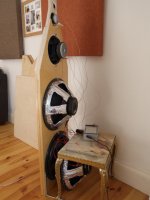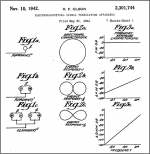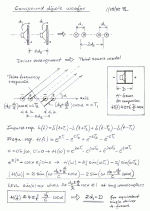Does anyone out there know what Bill Dudleston is doing with the bass alignment of the Whisper? It is a dipole, but what is he achieving with the second woofer behing the first?
Also, his woofers look more like the pro sound type without much excursion capability, but I keep reading on here that one must have high excursion to successfully have an open baffle. I have heard the Wisher twice and really liked the sound in the bass region.
Greg
Also, his woofers look more like the pro sound type without much excursion capability, but I keep reading on here that one must have high excursion to successfully have an open baffle. I have heard the Wisher twice and really liked the sound in the bass region.
Greg
An externally hosted image should be here but it was not working when we last tested it.
Been there, done that.
The Legacy Whispers use an outboard EQ box which controls the bass alignment (boost) and gives some flexibility over the in room response.
The compound woofers acts a bit like an ISO Barik configuration.
This set here was built with some pioneer woofers, sourced for a QTS of 0.6; not all that long a throw, but lots of cone area.
It's swept volume that counts... like a big V8.
~Jon
It is a dipole, but what is he achieving with the second woofer behing the first?
I've wondered this same thing. The Whisper write-ups I've read are quite coy on this point, saying only something about how they help further narrow bass dispersion.
On relatively narrow baffles like the Whisper's, two in-phase cones would serve to lengthen the the effective front-to-back path length without bringing Fp down into the passband.
I believe their close spacing also serves to raise their Qts, since half the airload damping is effectively removed from each cone.
Just guesses--I'd love to hear Bill D's answer.
The compound woofers acts a bit like an ISO Barik configuration.
But the purpose of that alignment is to lower Vas for small boxes--the opposite of what's normally considered ideal for OBs, where the best drivers have the largest Vas.
I am considering doing this compound woofer thing with some spare alpha 15a drivers I have. Seems ideal for the close sidewall issue such as that I suffer from.
There is a lack of interest in this going by my Google search, this clone attempt being the closest - though lacking in theoretical details (sub delay required, etc) Page Title
In the picture I propped up the spare 15" as an experiment. Will do the woodwork now, unless anyone hates the idea. 0.7 QTS is preferred so the alphas should work being high QTS!?
Bit of theory;
"Bill's goal with the Whisper is to reduce floor, ceiling and side-wall interactions by creating a "null" to the sides at all frequencies across the audio band. The photo above shows the compound woofer-loading technique Dudleston uses for the Whisper. The way the woofers interact creates an acoustical null in the bass on either side of the loudspeaker cabinet. "
There is a lack of interest in this going by my Google search, this clone attempt being the closest - though lacking in theoretical details (sub delay required, etc) Page Title
In the picture I propped up the spare 15" as an experiment. Will do the woodwork now, unless anyone hates the idea. 0.7 QTS is preferred so the alphas should work being high QTS!?
Bit of theory;
"Bill's goal with the Whisper is to reduce floor, ceiling and side-wall interactions by creating a "null" to the sides at all frequencies across the audio band. The photo above shows the compound woofer-loading technique Dudleston uses for the Whisper. The way the woofers interact creates an acoustical null in the bass on either side of the loudspeaker cabinet. "
Attachments
A good description can be seen here;
"Legacy describes the speaker as an "acoustic gun." This goal is no easy thing to accomplish with low frequencies. A large woofer in a box—any woofer in a box—will behave as an omnidirectional radiator. Dudleston therefore eliminated the woofer box entirely. The two pairs of closely-spaced back-to-front, in-phase 15" woofers behave like the twin diaphragms of some directional microphones; the result is a tight figure-8 directivity pattern with a null at the speaker's sides. (That there's a truly massive null at the speaker's sides can be confirmed easily by ear.) The Step One bass processor, installed between preamp and power amp(s), serves to adjust the Q and level of the woofers to let them couple effectively with the room without compromising their controlled dispersion. "
Legacy Audio Whisper loudspeaker | Stereophile.com
Further specifics here;
"Signals from the two baffles are combined acoustically with time compensation to steer the low frequency wave-launch forward, while creating a progressively reduced acoustic output to the sides until reaching a null at 90 degree off axis. "
Legacy Whisper XD Review
Since I run a Najda DSP unit - 4 (5 option coming) channel crossover - this is within reach for me.
"Legacy describes the speaker as an "acoustic gun." This goal is no easy thing to accomplish with low frequencies. A large woofer in a box—any woofer in a box—will behave as an omnidirectional radiator. Dudleston therefore eliminated the woofer box entirely. The two pairs of closely-spaced back-to-front, in-phase 15" woofers behave like the twin diaphragms of some directional microphones; the result is a tight figure-8 directivity pattern with a null at the speaker's sides. (That there's a truly massive null at the speaker's sides can be confirmed easily by ear.) The Step One bass processor, installed between preamp and power amp(s), serves to adjust the Q and level of the woofers to let them couple effectively with the room without compromising their controlled dispersion. "
Legacy Audio Whisper loudspeaker | Stereophile.com
Further specifics here;
"Signals from the two baffles are combined acoustically with time compensation to steer the low frequency wave-launch forward, while creating a progressively reduced acoustic output to the sides until reaching a null at 90 degree off axis. "
Legacy Whisper XD Review
Since I run a Najda DSP unit - 4 (5 option coming) channel crossover - this is within reach for me.
A bunch of marketing hype? You betcha! All that surface area of the cones flapping about with nowhere to go! Except curl right around the basket edge seeking out the rarafied air!
"like a big V8"....yeah, with pure slick ice on the ground....no traction to put down all that "power"!
__________________________________________________Rick............
"like a big V8"....yeah, with pure slick ice on the ground....no traction to put down all that "power"!
__________________________________________________Rick............
"Also, his woofers look more like the pro sound type without much excursion capability,"
that smacks of a negative connotation toward pro audio drivers bud! last time i checked a good many of them have x-max on par or greater than "audiophile"(read snooty, opinionated,class racist)speakers.
that smacks of a negative connotation toward pro audio drivers bud! last time i checked a good many of them have x-max on par or greater than "audiophile"(read snooty, opinionated,class racist)speakers.
That's a bunch of marketing goobly gook...
Actually it's not.. or perhaps it's not entirely.
What's happening with the bass-driver section is rather like achieving a hypercardioid radiation pattern - improving the null off-axis:
https://www.google.com/search?q=hyp...uCoOjyATI-4CgAg&ved=0CCoQsAQ&biw=1228&bih=664
Like a monopol, a dipole, or a cardioid: it still reacts to room modes.. but it usually reacts a bit differently ("shifting" the freq. response for the mode generated nulls and peaks).
Perhaps the most pertinent part relates to some degree of "enhanced" channel separation in the lower midrange/upper bass.
IMO that's actually the best part of the design.
The midrange section is the worst - which requires a far-field listening position.
No surprises this is a bit controversial then. It certainly does well as a whole speaker reviews/comments wise - sponsored or not. It was good enough for Steve Hoffman's recording studios which is no small thing I expect.
The speaker itself warranted a serious effort at cloning as shown in the link, but interest in the woofer design is not evident on the internet. Is it simply not worth the financial cost of doubling woofers for what must be a subtle if not room dependent gain?
The speaker itself warranted a serious effort at cloning as shown in the link, but interest in the woofer design is not evident on the internet. Is it simply not worth the financial cost of doubling woofers for what must be a subtle if not room dependent gain?
Celestion did this a very long time ago, with their dipole subwoofer for the SL600 speaker.
It used two bass driver, one behind the other. This technique allows for more swept volume without increasing overall baffle size, so keeping the profile very compact.
Although the relative phase responses can be adjusted to vary the response between dipole and some cardiod variant, I don't know id this was actually done.
There should be a paper from Graham Bank floating around somewhere that describes what he did.
Andrew
It used two bass driver, one behind the other. This technique allows for more swept volume without increasing overall baffle size, so keeping the profile very compact.
Although the relative phase responses can be adjusted to vary the response between dipole and some cardiod variant, I don't know id this was actually done.
There should be a paper from Graham Bank floating around somewhere that describes what he did.
Andrew
Gradient ?
Was there not (in addition to what you have described) some sort of offering
specificaly made to fit under the Quad Electrostatic ?
p.s. I met Bill at Axpona/Atlanta and asked about the Whisper's woofers.
His answer was that they were "differential". Still to this day, I do not know what he meant.
Celestion did this a very long time ago, with their dipole subwoofer for the SL600 speaker.
It used two bass driver, one behind the other. This technique allows for more swept volume without increasing overall baffle size, so keeping the profile very compact.
Although the relative phase responses can be adjusted to vary the response between dipole and some cardiod variant, I don't know id this was actually done.
There should be a paper from Graham Bank floating around somewhere that describes what he did.
Andrew
Was there not (in addition to what you have described) some sort of offering
specificaly made to fit under the Quad Electrostatic ?
p.s. I met Bill at Axpona/Atlanta and asked about the Whisper's woofers.
His answer was that they were "differential". Still to this day, I do not know what he meant.
Looks to me the whisper has added drivers to bring up the sensitivity, that's about the only way to do it other then bigger motors (that have higher rolloff) so to fit them on the board the goofballs just stuck them on the back panel. It's pretty funny what some people will actually pay for
p.s. I met Bill at Axpona/Atlanta and asked about the Whisper's woofers.
His answer was that they were "differential". Still to this day, I do not know what he meant.
A quote from one of their earlier brochures:
“Differential technology:
Whisper’s compound alignment is rooted in Harry Olsen’s early papers more than twenty-five years ago. (Olsen is legendary for his mathematical and acoustic modeling of microphones). Olsen suggested such an alignment as a way to effectively steer low frequencies. Whisper is the first broadband realization of this differential technique…
The low frequency drivers operate in phase with each other and combine acoustically as a pair of figure- of-eights, one behind the other. The result: a compound null formed at the sides of the enclosure, which minimizes resonances and room reflections.”
From there, internet searches for “differential microphones” or “gradient microphones” will help explain.
Basically Olson developed microphones that used difference in phase between several elements to provide directional control of the pickup pattern at low frequencies. That is where the word “differential” comes from. The attached pic from one of his patents shows how the directivity could be increased with additional elements. Figure 1a/2a/3a are for a monopole. Figure 1b/2b/3b are for a dipole(notice the familiar cosine directivity function). Figure 1c/2c/3c are for a compound dipole where the directivity is increased to cosine^2)
Olson also developed directional loudspeaker arrays using these same techniques.
https://secure.aes.org/forum/pubs/journal/?elib=2006
However, the Whisper drives its compound woofers in phase(different from Olson) so the directivity pattern will be the same as for a single dipole woofer at low frequencies. Linkwitz has analyzed this configuration and also seemed at a loss as to what advantages there might be.
Electro-acoustic models
The most obvious advantage has already been mentioned, increased output with no increase in baffle size. When experimenting with this setup many years ago, there were two other advantages I noted. For the same output, the compound dipole will have its dipole peak and null an octave higher in frequency. Also, for the same output, the compound dipole will lack any cavity resonance when compared to an H frame or similar dipole woofer. Both of these would be important in the Whisper as the compound woofers are not being used just as subwoofers, but need to operate cleanly up to(past) the 300Hz crossover point with the mids. The reason for this high crossover point is to keep the directivity controlled below 300 hz where the size of midrange array is starting to look acoustically small.
Celestion did this a very long time ago, with their dipole subwoofer for the SL600 speaker.
It used two bass driver, one behind the other. This technique allows for more swept volume without increasing overall baffle size, so keeping the profile very compact.
Although the relative phase responses can be adjusted to vary the response between dipole and some cardiod variant, I don't know id this was actually done.
There should be a paper from Graham Bank floating around somewhere that describes what he did.
Not sure if this is the paper you were talking about, but attached is an old white paper on the Celestion System 6000 I’ve had in my files for quite some time. Discussion of the subwoofer begins on page 3. One interesting thing I noted was that they intended for the left and right channel subwoofer arrays to be rotated or oriented independently from the satellites to adjust the excitation of the different room modes for smoothest bass response.
Attachments
Last edited:
SAC ... if you do a ripple tank simulation of the bass drivers connected out of phase the resulting nulls at 90* are very pronounced with a close enough approximation of 90* fore and aft.
Same distance between drivers in the ripple sim .. connected in phase .. produces four or more nulls including the on axis position. As one would use digital delay, increasing the spacing between the drivers (connected in phase) does increase forward radiation but not at the intensity level of the drivers wired out of phase.
All of this does seem to be at the mercy of frequency. Some ranges offer very nice patterns ... some don't. I wonder if the electronics developed by Mr. Duddleston formulates a time/frequency curve to maintain the desired directivity in the bass operating range.
Same distance between drivers in the ripple sim .. connected in phase .. produces four or more nulls including the on axis position. As one would use digital delay, increasing the spacing between the drivers (connected in phase) does increase forward radiation but not at the intensity level of the drivers wired out of phase.
All of this does seem to be at the mercy of frequency. Some ranges offer very nice patterns ... some don't. I wonder if the electronics developed by Mr. Duddleston formulates a time/frequency curve to maintain the desired directivity in the bass operating range.
- Status
- This old topic is closed. If you want to reopen this topic, contact a moderator using the "Report Post" button.
- Home
- Loudspeakers
- Multi-Way
- Legacy Whisper bass?


